The entry route to sheep farming has been much different for Lawrence Martin, who farms in a partnership-type arrangement with Daye and Willie Tucker in Carbeth Home Farm, a short distance from Loch Lomand and the Trossachs National Park in Scotland.
While Lawrence always had an interest in agriculture he was not from a farming background and the chances of developing this interest seemed little more than a pipe dream when he completed a degree in economics and undertook a role in project management and finance.
The role, while challenging, did not excite Lawrence and he found himself following farmers on social media. He says he struck up a relationship about eight years ago with Daye Tucker who had purchased the 162ha (400 acre) farm with her husband Willie following retirement in the early 2000s. From there his interest grew and he found himself looking at how he could gain experience and find an entry route in to farming.
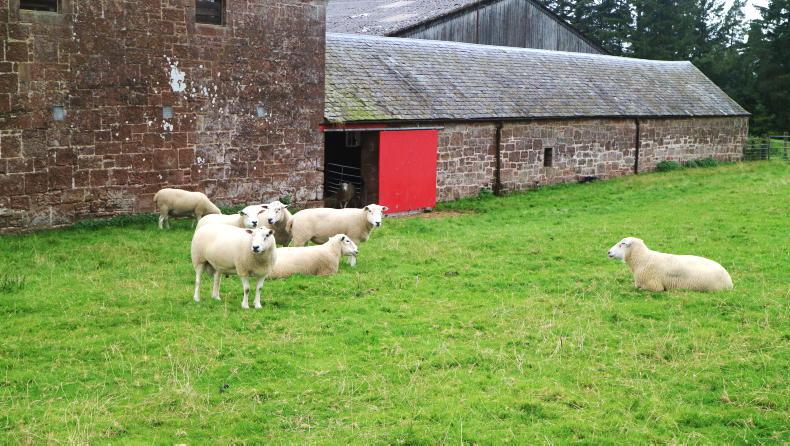
He completed a husbandry-based agricultural course in Scotland’s Rural College (SRUC) along with a farm apprenticeship on Carbeth Home Farm. The relationship developed from there and two years ago Lawrence quit his job, selling his house and moving in to a full-time partnership-type role with the Tuckers.
Farm history
The farm was part of a 2,000ha estate that was farmed as a potato farm and dairy farm before being purchased by the Tuckers. It was initially farmed as a livery by Daye before transitioning to predominately a sheep farm. Situated amidst a stronghold of intensive dairy holdings, part of the farm has also been rented out on a short-term basis in recent years for cutting of hay and silage. Lawrence says the ethos on the farm is different than the surrounding hinterland, with a more extensive system of farming without the use of synthetic fertiliser. Some slurry and digestate is imported to lands used for cropping.
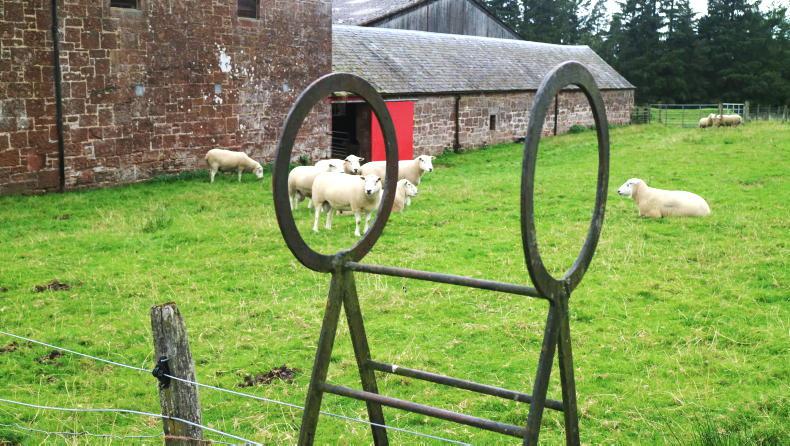
There is also a significant area in natural woodlands and there are two sections of agro-forestry which will be planted 15 years in 2023 and can be then grazed by livestock. Lawrence says: “The farm is carbon negative [using the SAC Agrecalc calculator], with woodland contributing significantly and the farming system is also improving every year. We are not organic but farm with organic principles and use no [chemical] fertiliser. We could practically be organic but cannot afford the cost of organic feed. This might change as we explore different sward types.”
Useful background
Lawrence’s background in economics has taught him the power of analysing data and this has had a profound influence on the sheep flock. The catalyst for change has been the introduction of a system of performance recording to identify elite performing animals to select replacements from and select poor-performing animals for culling.
This has seen numbers in the Lleyn ewe flock fluctuate from almost 600 head to its lowest level of 250 mature ewes. The focus in recent years has been on building numbers but with the right type of sheep. “When we started culling out the poor-performing ewes it was unreal the difference it made to performance. We had the same number of lambs from over 100 fewer ewes and this gave us the confidence to progress with such a culling policy.”
Balanced ewe
Lawrence and Daye’s aim is to breed a ewe that is balanced in terms of prolificacy, mature ewe liveweight, milk yield, mothering ability etc. An industry criticism which has sometimes surfaced among farmers with a strain of the Lleyn breed with a low mature weight is that progeny grow excellently until they reach 36kg to 40kg and then take time to mature beyond this weight.
Through selecting elite-performing animals, Lawrence focuses on breeding from ewes that deliver high-performing lambs without compromising too much on ewe liveweight and the benefits of running a smaller ewe. He is a member of the Lleyn Gold breeding initiative which aims to identify superior-performing replacements and elite genetics.
Ewes are not culled on age at present, with the flock growing numbers and less pressure on aged ewes. However, any ewes which are repeat offenders in terms of lameness or display poor mothering ability are culled.
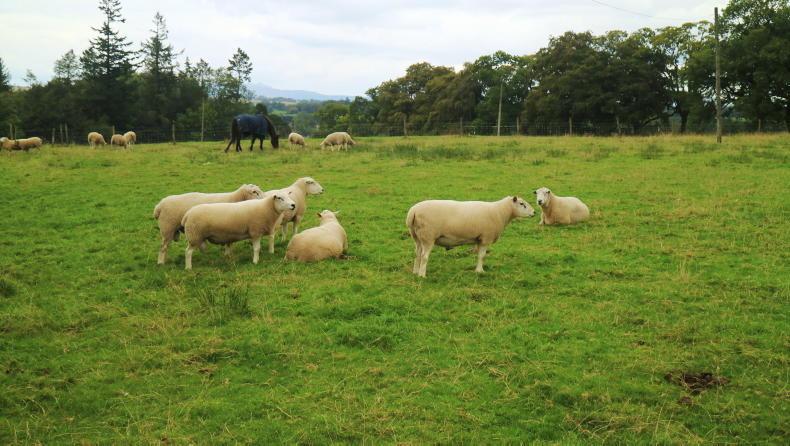
The farm's breeding programme is focused on identifying superior performance genetics.
There is also a strong focus on incorporating replacements that can perform on forage: “Ewe lambs don’t get any priority treatment and don’t get any feeding. There is a bigger batch selected than required and if any don’t perform they are transferred to a batch of culls and out the door. I am reasonably lenient on gimmers [hoggets] in their first season but if one lambs and buggers off then she gets a red dot and is also gone.”
Flock output
The flock currently stands at 450 mature ewes and the aim is to get this to 500 to 550 high-performing ewes and see if there is scope to grow this number in a sustainable manner that doesn’t put excessive pressure on feed resources.
“This farm could easily carry 1,000 ewes and their progeny but in an intensive system. This is not the way we see ourselves progressing. We know we can get a lot more from the farm but through addressing soil fertility through our liming programme, improving grazing infrastructure and managing grass more efficiently and utilising herbal leys.”
The current scanning rate is 205%, with the weaning rate in 2022 recorded at an excellent rate of 190%. Lawrence attributes this performance to high levels of supervision and the breeding programme starting to pay dividends.
“Labour on the farm is me, my wife Ella, and Daye also helps out greatly. I won’t lie, this year’s lambing was pretty challenging. We split lambing to lamb indoors due to the intensive nature of recording. It is the first and last year we will split lambing. It goes on too long and the jobs you should be doing with young lambs out in the fields and getting grazing set up you can’t do as you are still in the shed looking after lambs”.
In the coming season, Lawrence plans to lamb about 100 commercial mature Lleyn ewes outdoors. He is also experimenting with joining a proportion of these ewes with a Charollais x Beltex ram to see what influence it has on lambing and subsequent performance.
Lamb sales
The traditional system has been to finish lambs on farms. Lambs not finished by October are brought indoors as they reach 38kg to 40kg and then finished intensively on concentrates over a short feeding period. Given the high cost of concentrates and the strength of the store lamb market, a decision will be made following completion of a finishing budget as to whether to dip in to the store trade to market the final lambs.
Technology advancements
The farm has made strategic use of grant aid schemes to improve handling facilities and invest in technology to bring the business forward. The main handling unit revolves around a Ritchie combi clamp with automatic EID reading technology and an auto drafter.
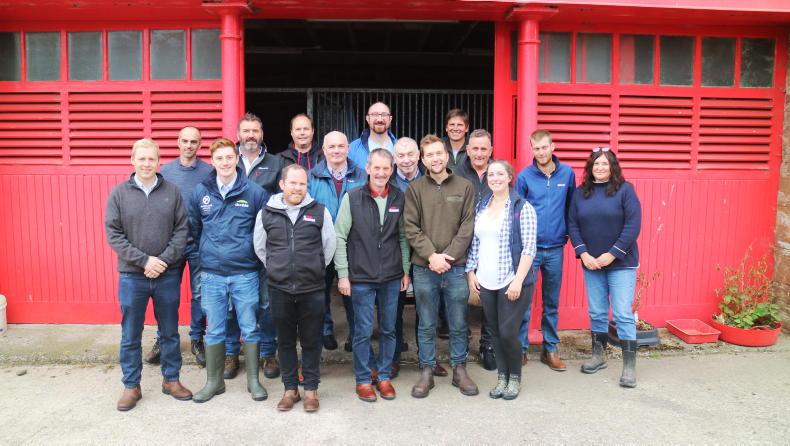
Members of the Northern Ireland Sheep Programme on their visit to Carbeth Farm and pictured with Lawrence and Ella Martin.
With regard to performance recording, Lawrence advises that the data collected is only as good as the use that is made of it. “The first implementation takes months when you are getting all your ewe data and breeding data captured but the value of having this massively exceeds the time it takes to collect it. There is so much information you can collect and the best results are achieved by focusing on what is important for your flock. The weighing scales is still one of the most important pieces of equipment I have – it gives you invaluable information on performance and kill out which influence so many decisions.”
Worm treatment
Animals are treated for worms on a combination of faecal egg counts and monitoring performance. Lawrence carries out the faecal egg counts using a simple microscope and learned the process by watching tutorial videos from the SRUC and submitting samples to his veterinary practitioner so that he could cross-reference results.
He also carries out targeted selective treatment whereby the performance of lambs since their last weighing is displayed when they are weighed. Any lamb gaining over the figure set is not treated while lambs below this figure receive treatment.
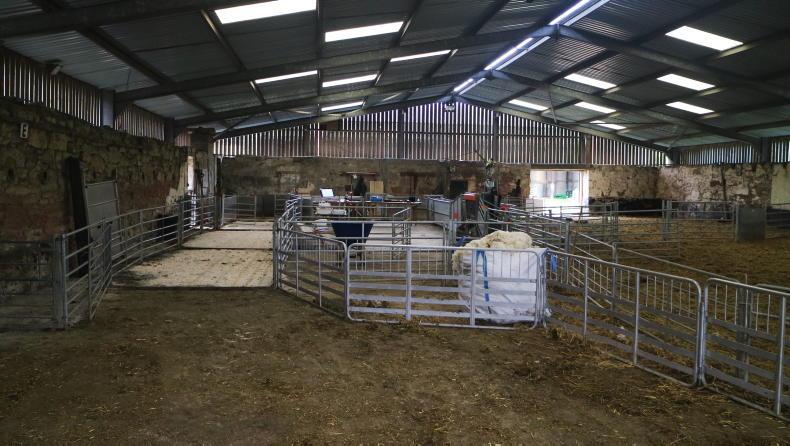
The handling unit revolves around a Ritchie combi-clamp and can be dismantled or altered easily to free up the shed for other uses such as lambing.
The farm also made a significant investment in a Te Pari Smart Dosing Gun. The gun has inbuilt Wi-Fi which connects with a phone app or weigh head. If a lamb needs treatment then the gun will automatically administer the recommended volume going on the lamb’s weight. It is estimated that so far this season anthelmintic use has reduced from over 50l to 12l.
Faecal egg count reduction tests are also used to test for resistance, with the farm having significant resistance to yellow drenches. The breeding programme is also starting to utilise information on worm resilience.
Suckler herd
Lawrence has established a small herd of Galloway and Highland-Galloway-cross heifers which will calve down in 2023. The aim of this is to develop a hardy cow with a lower mature weight that can winter outdoors on deferred grazing and be sustained on more marginal ground.
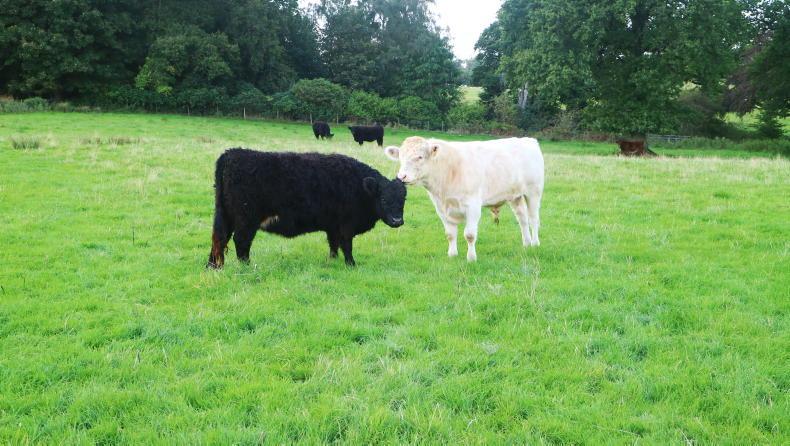
A Galloway heifer pictured alongside Lawrence's White Shorthorn bull.
The goal is to breed the traditional Blue Grey heifer for sale which is a cross between a Galloway and White Shorthorn. He says there is increasing demand for this cross on hill areas. Outwintering the herd will reduce feed costs and utilise more marginal grazing areas not fully utilised by sheep, while also freeing up shed space to operate a B and B system.
The herd is awaiting high herd health status accreditation which covers a number of diseases including TB, Johnes and BVD. Lawrence has also established a small flock of Herdwick sheep which along with the Lleyn flock have Maedi Visna-free accreditation. This is becoming an increasing sought after accreditation with the disease feared to be on the rise.
Future direction
As mentioned previously the aim is to continue to improve breeding in the ewe flock while there is significant potential to improve performance from grazed grass. The farm has experimented with a multispecies sward including traditional grass varieties of Timothy and a new variety of Cocksfoot which is marked as being more palatable.
The venture in to multispecies swards has been positive and this will continue with a view to replacing swards which have been recorded using the AgriWebb farm software package as delivering a poor yield.
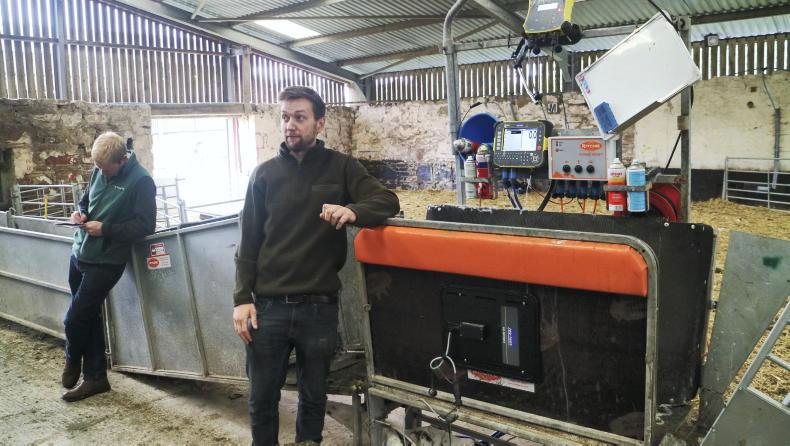
Lawrence Martin giving a display of how the combi clamp works and explaining targeted selective treatment of lambs.
Lawrence also has plans to capitalise on demand for feed in the area by selling surplus feed and taking in animals for wintering on a B and B basis over the winter. “The ultimate aim is to continue to develop a farming system that gives Ella and our son Oliver a good quality of life and gives Daye and Willie a positive payback for the trust they have shown to me.”
The entry route to sheep farming has been much different for Lawrence Martin, who farms in a partnership-type arrangement with Daye and Willie Tucker in Carbeth Home Farm, a short distance from Loch Lomand and the Trossachs National Park in Scotland.
While Lawrence always had an interest in agriculture he was not from a farming background and the chances of developing this interest seemed little more than a pipe dream when he completed a degree in economics and undertook a role in project management and finance.
The role, while challenging, did not excite Lawrence and he found himself following farmers on social media. He says he struck up a relationship about eight years ago with Daye Tucker who had purchased the 162ha (400 acre) farm with her husband Willie following retirement in the early 2000s. From there his interest grew and he found himself looking at how he could gain experience and find an entry route in to farming.

He completed a husbandry-based agricultural course in Scotland’s Rural College (SRUC) along with a farm apprenticeship on Carbeth Home Farm. The relationship developed from there and two years ago Lawrence quit his job, selling his house and moving in to a full-time partnership-type role with the Tuckers.
Farm history
The farm was part of a 2,000ha estate that was farmed as a potato farm and dairy farm before being purchased by the Tuckers. It was initially farmed as a livery by Daye before transitioning to predominately a sheep farm. Situated amidst a stronghold of intensive dairy holdings, part of the farm has also been rented out on a short-term basis in recent years for cutting of hay and silage. Lawrence says the ethos on the farm is different than the surrounding hinterland, with a more extensive system of farming without the use of synthetic fertiliser. Some slurry and digestate is imported to lands used for cropping.

There is also a significant area in natural woodlands and there are two sections of agro-forestry which will be planted 15 years in 2023 and can be then grazed by livestock. Lawrence says: “The farm is carbon negative [using the SAC Agrecalc calculator], with woodland contributing significantly and the farming system is also improving every year. We are not organic but farm with organic principles and use no [chemical] fertiliser. We could practically be organic but cannot afford the cost of organic feed. This might change as we explore different sward types.”
Useful background
Lawrence’s background in economics has taught him the power of analysing data and this has had a profound influence on the sheep flock. The catalyst for change has been the introduction of a system of performance recording to identify elite performing animals to select replacements from and select poor-performing animals for culling.
This has seen numbers in the Lleyn ewe flock fluctuate from almost 600 head to its lowest level of 250 mature ewes. The focus in recent years has been on building numbers but with the right type of sheep. “When we started culling out the poor-performing ewes it was unreal the difference it made to performance. We had the same number of lambs from over 100 fewer ewes and this gave us the confidence to progress with such a culling policy.”
Balanced ewe
Lawrence and Daye’s aim is to breed a ewe that is balanced in terms of prolificacy, mature ewe liveweight, milk yield, mothering ability etc. An industry criticism which has sometimes surfaced among farmers with a strain of the Lleyn breed with a low mature weight is that progeny grow excellently until they reach 36kg to 40kg and then take time to mature beyond this weight.
Through selecting elite-performing animals, Lawrence focuses on breeding from ewes that deliver high-performing lambs without compromising too much on ewe liveweight and the benefits of running a smaller ewe. He is a member of the Lleyn Gold breeding initiative which aims to identify superior-performing replacements and elite genetics.
Ewes are not culled on age at present, with the flock growing numbers and less pressure on aged ewes. However, any ewes which are repeat offenders in terms of lameness or display poor mothering ability are culled.

The farm's breeding programme is focused on identifying superior performance genetics.
There is also a strong focus on incorporating replacements that can perform on forage: “Ewe lambs don’t get any priority treatment and don’t get any feeding. There is a bigger batch selected than required and if any don’t perform they are transferred to a batch of culls and out the door. I am reasonably lenient on gimmers [hoggets] in their first season but if one lambs and buggers off then she gets a red dot and is also gone.”
Flock output
The flock currently stands at 450 mature ewes and the aim is to get this to 500 to 550 high-performing ewes and see if there is scope to grow this number in a sustainable manner that doesn’t put excessive pressure on feed resources.
“This farm could easily carry 1,000 ewes and their progeny but in an intensive system. This is not the way we see ourselves progressing. We know we can get a lot more from the farm but through addressing soil fertility through our liming programme, improving grazing infrastructure and managing grass more efficiently and utilising herbal leys.”
The current scanning rate is 205%, with the weaning rate in 2022 recorded at an excellent rate of 190%. Lawrence attributes this performance to high levels of supervision and the breeding programme starting to pay dividends.
“Labour on the farm is me, my wife Ella, and Daye also helps out greatly. I won’t lie, this year’s lambing was pretty challenging. We split lambing to lamb indoors due to the intensive nature of recording. It is the first and last year we will split lambing. It goes on too long and the jobs you should be doing with young lambs out in the fields and getting grazing set up you can’t do as you are still in the shed looking after lambs”.
In the coming season, Lawrence plans to lamb about 100 commercial mature Lleyn ewes outdoors. He is also experimenting with joining a proportion of these ewes with a Charollais x Beltex ram to see what influence it has on lambing and subsequent performance.
Lamb sales
The traditional system has been to finish lambs on farms. Lambs not finished by October are brought indoors as they reach 38kg to 40kg and then finished intensively on concentrates over a short feeding period. Given the high cost of concentrates and the strength of the store lamb market, a decision will be made following completion of a finishing budget as to whether to dip in to the store trade to market the final lambs.
Technology advancements
The farm has made strategic use of grant aid schemes to improve handling facilities and invest in technology to bring the business forward. The main handling unit revolves around a Ritchie combi clamp with automatic EID reading technology and an auto drafter.

Members of the Northern Ireland Sheep Programme on their visit to Carbeth Farm and pictured with Lawrence and Ella Martin.
With regard to performance recording, Lawrence advises that the data collected is only as good as the use that is made of it. “The first implementation takes months when you are getting all your ewe data and breeding data captured but the value of having this massively exceeds the time it takes to collect it. There is so much information you can collect and the best results are achieved by focusing on what is important for your flock. The weighing scales is still one of the most important pieces of equipment I have – it gives you invaluable information on performance and kill out which influence so many decisions.”
Worm treatment
Animals are treated for worms on a combination of faecal egg counts and monitoring performance. Lawrence carries out the faecal egg counts using a simple microscope and learned the process by watching tutorial videos from the SRUC and submitting samples to his veterinary practitioner so that he could cross-reference results.
He also carries out targeted selective treatment whereby the performance of lambs since their last weighing is displayed when they are weighed. Any lamb gaining over the figure set is not treated while lambs below this figure receive treatment.

The handling unit revolves around a Ritchie combi-clamp and can be dismantled or altered easily to free up the shed for other uses such as lambing.
The farm also made a significant investment in a Te Pari Smart Dosing Gun. The gun has inbuilt Wi-Fi which connects with a phone app or weigh head. If a lamb needs treatment then the gun will automatically administer the recommended volume going on the lamb’s weight. It is estimated that so far this season anthelmintic use has reduced from over 50l to 12l.
Faecal egg count reduction tests are also used to test for resistance, with the farm having significant resistance to yellow drenches. The breeding programme is also starting to utilise information on worm resilience.
Suckler herd
Lawrence has established a small herd of Galloway and Highland-Galloway-cross heifers which will calve down in 2023. The aim of this is to develop a hardy cow with a lower mature weight that can winter outdoors on deferred grazing and be sustained on more marginal ground.

A Galloway heifer pictured alongside Lawrence's White Shorthorn bull.
The goal is to breed the traditional Blue Grey heifer for sale which is a cross between a Galloway and White Shorthorn. He says there is increasing demand for this cross on hill areas. Outwintering the herd will reduce feed costs and utilise more marginal grazing areas not fully utilised by sheep, while also freeing up shed space to operate a B and B system.
The herd is awaiting high herd health status accreditation which covers a number of diseases including TB, Johnes and BVD. Lawrence has also established a small flock of Herdwick sheep which along with the Lleyn flock have Maedi Visna-free accreditation. This is becoming an increasing sought after accreditation with the disease feared to be on the rise.
Future direction
As mentioned previously the aim is to continue to improve breeding in the ewe flock while there is significant potential to improve performance from grazed grass. The farm has experimented with a multispecies sward including traditional grass varieties of Timothy and a new variety of Cocksfoot which is marked as being more palatable.
The venture in to multispecies swards has been positive and this will continue with a view to replacing swards which have been recorded using the AgriWebb farm software package as delivering a poor yield.

Lawrence Martin giving a display of how the combi clamp works and explaining targeted selective treatment of lambs.
Lawrence also has plans to capitalise on demand for feed in the area by selling surplus feed and taking in animals for wintering on a B and B basis over the winter. “The ultimate aim is to continue to develop a farming system that gives Ella and our son Oliver a good quality of life and gives Daye and Willie a positive payback for the trust they have shown to me.”








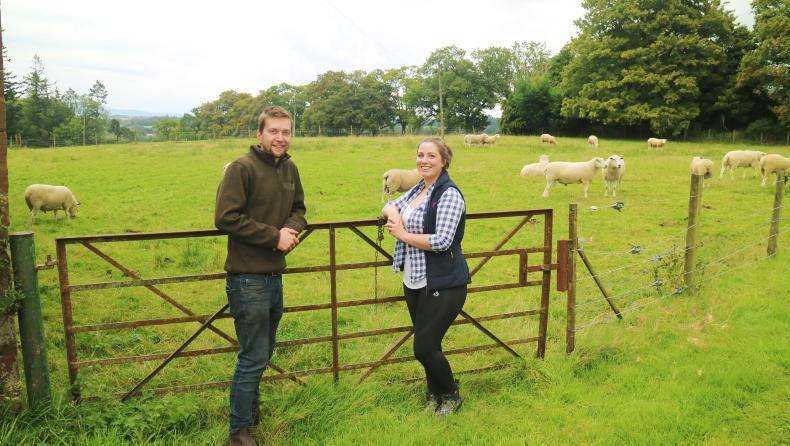




 This is a subscriber-only article
This is a subscriber-only article










SHARING OPTIONS: